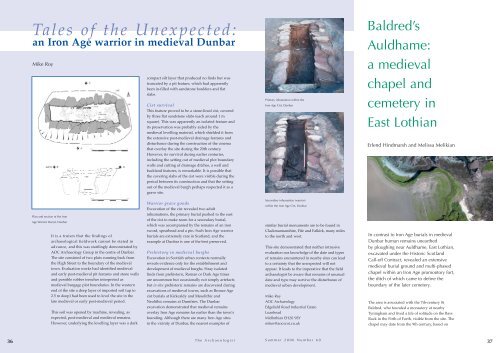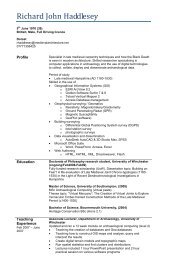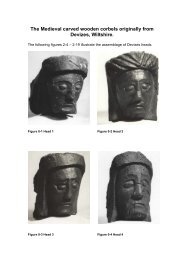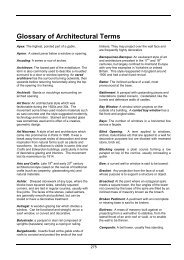The ARCHAEOLOGIST - English Late-Medieval timber-framed ...
The ARCHAEOLOGIST - English Late-Medieval timber-framed ...
The ARCHAEOLOGIST - English Late-Medieval timber-framed ...
Create successful ePaper yourself
Turn your PDF publications into a flip-book with our unique Google optimized e-Paper software.
Tales of the Unexpected:<br />
an Iron Age warrior in medieval Dunbar<br />
Mike Roy<br />
compact silt layer that produced no finds but was<br />
truncated by a pit feature, which had apparently<br />
been in-filled with sandstone boulders and flat<br />
slabs.<br />
Cist survival<br />
This feature proved to be a stone-lined cist, covered<br />
by three flat sandstone slabs (each around 1 m<br />
square). This was apparently an isolated feature and<br />
its preservation was probably aided by the<br />
medieval levelling material, which shielded it from<br />
the extensive post-medieval drainage features and<br />
disturbance during the construction of the cinema<br />
that overlay the site during the 20th century.<br />
However, its survival during earlier centuries,<br />
including the setting out of medieval plot boundary<br />
walls and cutting of drainage ditches, a well and<br />
backland features, is remarkable. It is possible that<br />
the covering slabs of the cist were visible during the<br />
period between its construction and that the setting<br />
out of the medieval burgh perhaps respected it as a<br />
grave site.<br />
Primary inhumation within the<br />
Iron Age Cist, Dunbar<br />
Baldred’s<br />
Auldhame:<br />
a medieval<br />
chapel and<br />
cemetery in<br />
East Lothian<br />
Erlend Hindmarsh and Melissa Melikian<br />
Plan and section of the Iron<br />
Age Warrior Burial, Dunbar<br />
It is a truism that the findings of<br />
archaeological fieldwork cannot be stated in<br />
advance, and this was startlingly demonstrated by<br />
AOC Archaeology Group in the centre of Dunbar.<br />
<strong>The</strong> site consisted of two plots running back from<br />
the High Street to the boundary of the medieval<br />
town. Evaluation works had identified medieval<br />
and early post-medieval pit features and stone walls<br />
and possible robber trenches interpreted as<br />
medieval burgage plot boundaries. In the western<br />
end of the site a deep layer of imported soil (up to<br />
2.5 m deep) had been used to level the site in the<br />
late medieval or early post-medieval period.<br />
This soil was opened by machine, revealing, as<br />
expected, post-medieval and medieval remains.<br />
However, underlying the levelling layer was a dark<br />
Warrior grave goods<br />
Excavation of the cist revealed two adult<br />
inhumations, the primary burial pushed to the east<br />
of the cist to make room for a secondary burial,<br />
which was accompanied by the remains of an iron<br />
sword, spearhead and a pin. Such Iron Age warrior<br />
burials are extremely rare in Scotland, and the<br />
example at Dunbar is one of the best preserved.<br />
Prehistory in medieval burghs<br />
Excavation in Scottish urban contexts normally<br />
reveals evidence only for the establishment and<br />
development of medieval burghs. Stray isolated<br />
finds from prehistoric, Roman or Dark Age times<br />
are uncommon but occasionally not simply artefacts<br />
but in situ prehistoric remains are discovered during<br />
excavations of medieval towns, such as Bronze Age<br />
cist burials at Kirkcaldy and Mesolithic and<br />
Neolithic remains at Dumfries. <strong>The</strong> Dunbar<br />
excavation demonstrated that medieval remains<br />
overlay Iron Age remains far earlier than the town’s<br />
founding. Although there are many Iron Age sites<br />
in the vicinity of Dunbar, the nearest examples of<br />
Secondary inhumation (warrior)<br />
within the Iron Age Cist, Dunbar<br />
similar burial monuments are to be found in<br />
Clackmannanshire, Fife and Falkirk, many miles<br />
to the north and west.<br />
This site demonstrated that neither intrusive<br />
evaluation nor knowledge of the date and types<br />
of remains encountered in nearby sites can lead<br />
to a certainty that the unexpected will not<br />
appear. It leads to the imperative that the field<br />
archaeologist be aware that remains of unusual<br />
date and type may survive the disturbance of<br />
medieval urban development.<br />
Mike Roy<br />
AOC Archaeology<br />
Edgefield Road Industrial Estate<br />
Loanhead<br />
Midlothian EH20 9SY<br />
miker@aocscot.co.uk<br />
In contrast to Iron Age burials in medieval<br />
Dunbar human remains unearthed<br />
by ploughing near Auldhame, East Lothian,<br />
excavated under the Historic Scotland<br />
Call-off Contract, revealed an extensive<br />
medieval burial ground and multi-phased<br />
chapel within an Iron Age promontory fort,<br />
the ditch of which came to define the<br />
boundary of the later cemetery.<br />
<strong>The</strong> area is associated with the 7th-century St<br />
Baldred, who founded a monastery at nearby<br />
Tyningham and lived a life of solitude on the Bass<br />
Rock in the Firth of Forth, visible from the site. <strong>The</strong><br />
chapel may date from the 9th century, based on<br />
36<br />
<strong>The</strong> Archaeologist Summer 2006 Number 60<br />
37





